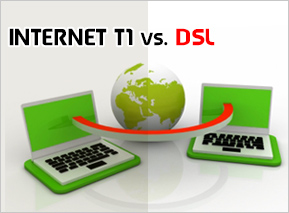Not long ago, high-speed Internet connections were not only expensive, but difficult to come by. Thankfully that is no longer the case, as there are a number of broadband access options for even the most remote businesses.
 The traditional high-speed Internet connection for businesses is the Internet T1 line. An Internet T1 line is an always-on, dedicated connection that offers symmetrical speeds (same upload and download) of 1.5Mb. T1 lines are typically purchased for a 1, 2 or 3 year lease and come with Service Level Agreements (SLAs) that guarantee bandwidth, service uptime, and additional parameters such as latency and jitter.
The traditional high-speed Internet connection for businesses is the Internet T1 line. An Internet T1 line is an always-on, dedicated connection that offers symmetrical speeds (same upload and download) of 1.5Mb. T1 lines are typically purchased for a 1, 2 or 3 year lease and come with Service Level Agreements (SLAs) that guarantee bandwidth, service uptime, and additional parameters such as latency and jitter.
DSL, on the other hand, is a shared bandwidth service that is most often used by small or at-home offices. Unlike a T1 line, DSL offers asymmetrical speeds – with download speeds higher than upload speeds – that vary depending upon the provider you choose. While DSL does not offer SLAs, its biggest selling point is its relatively inexpensive price.
One of the largest differences between an Internet T1 line and DSL service is their classification. A T1 connection is a dedicated service, meaning the bandwidth you purchase is dedicated solely to you and your business. Today, T1 connections are virtually ubiquitous, even the most remote locations. DSL, conversely, is considered an information service. Due to the fact that information services are regulated differently than telecommunications services, DSL is offered on an as-available basis.
Another big difference between a T1 line and DSL service is that DSL does not provide SLAs, so there is no guarantee as to availability or repair time in the event of an outage. Moreover, DSL is frequently over-subscribed by providers in an effort to keep costs low. Providers assume that only a certain number of customers will be online at any given time and therefore sell more connections than they have bandwidth to support. Essentially it’s the same as airlines overbooking flights. The upside is that it allows DSL providers to offer their services at rates much lower than T1 lines; however these connections slow down significantly during peak hours when the majority of subscribers are online, so even when your connection is working, your bandwidth will fluctuate.
If you’re still unsure as to what connection is best for your business, give us a call today. We’ll work with you to determine the ideal service that fits your business’s unique needs and budget.
Image Source: jscreationzs / FreeDigitalPhotos.net


